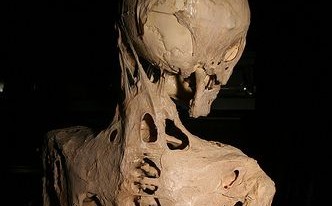An alarming, frightening, and ultimately lethal mystery first uncovered by Dr. John Freke in April of 1736 may very well be on its way to a resolution—thanks to the help of determined physicians and 21st-century medical technology. After examination of a patient who presented complaining of “large swellings” on his back, Freke described a disease he had never before seen, stating that the swellings “arise from all vertebrae of the neck and reach down to the os sacrum…joining together in all parts of his back, as the ramifications of coral do, to make a fixed bony pair of bodice” (The Chirurgeon’s Apprentice). He summed up the patient’s condition in two words, by referring to him as the “Stone Man.” Although more instances of the disease were discovered over time, this mysterious affliction was not officially given a name until the 1970s, when Dr. Victor McKusick of Johns Hopkins University School of Medicine recognized it as Fibrodysplasia Ossificans Progressiva (FOP). Although exhibiting very similar characteristics, this disease is not to be confused with Greyscale, the disease from which Shireen Baratheon of Game of Thrones suffers even though characters of the show who had Greyscale were referred to as “Stone Men” as well.
Today, nearly 3300 people worldwide suffer from Fibrodysplasia Ossificans Progressiva, a disease in which the connective tissue, ligaments, and tendons of the body progressively morph into sheets of bone, essentially ossifying the body over time, due to a mutation in ACVR1, a BMP receptor. Under normal conditions, this gene provides instructions for producing BMP receptors and helping to transform cartilage into bone. The mutation changes the shape of BMP receptors, essentially keeping them consistently “on” and continuously forming bone. Eventually, this autosomal dominant disease can cause the jaw to become stiff and locked, preventing the individual from eating, and the vertebral column will become completely fused, leading to severely restricted movement. As motility begins to deteriorate, individuals with FOP frequently succumb to respiratory infections and heart failure and die prematurely.
Up until just recently, there was no cure for this devastating disease. Originally, glucocorticoids were the only method of relief for the patient by helping to reduce inflammation. However, promising research at Regeneron Pharmaceuticals in New York may have found an answer in a new therapy that targets a protein called activin A. Normally, ACVR1 produces a cell surface protein called a transmembrane receptor, but FOP interrupts the way this receptor responds to activin A, causing it to go into overdrive when it should normally be suppressed. Scientists used antibodies to prevent activin A from triggering the ACVR1 gene, and in mice studies, this was shown to prevent the growth of new bone for up to six weeks. Regeneron is now in the process of setting up clinical tests in humans to see if the mystery behind Fibrodysplasia Ossificans Progressiva can be broken once and for all.
- “History of FOP.” History of FOP. International Fibrodysplasia Ossificans Association, 2009. Web. 31 Oct. 2015.
- “Fibrodysplasia Ossificans Progressiva.” Https://www.themedicalbag.com/raredisease/fibrodysplasia-ossificans-progressiva. Medical Bag, 27 Sept. 2012. Web. 15 Oct. 2015
- “Fibrodysplasia Ossificans Progressiva – NORD (National Organization for Rare Disorders).” NORD National Organization for Rare Disorders Fibrodysplasia Ossificans Progressiva Comments. Fibrodysplasia Ossificans Progressiva. Web. 31 Oct. 2015.
- O’Callaghan, Jonathan. “Possible Cure Found For Rare “Stone Man” Disease That Turns Muscle To Bone.” IFLScience. Health and Medicine, 3 Sept. 2015. Web. 31 Oct. 2015.
Rachel Antol is an MS2 at The University of Arizona College of Medicine – Phoenix. She graduated from Arizona State University in 2014 with a degree in biology and a concentration in developmental biology. Growing up with a passion for reading and writing, Rachel has been involved in various writing opportunities throughout her life and is very excited to bring this joy to her medical school. For any questions or interest in submitting an article, please contact her at rachelantol[at]email.arizona.edu.

